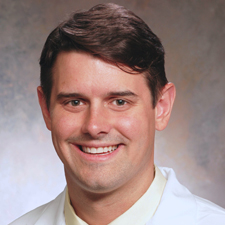A coordinated public health approach is needed to combat the evolving challenges presented by the opioid epidemic that kills nearly 180 Americans every day. Yet there are clear steps that physicians and health care organizations can take to reduce opioid-related harm while providing effective and compassionate care.
At the University of Chicago Medicine system, physicians are undertaking efforts that make greater use of data and analysis of prescribing patterns, non-opioid pain-management approaches and improved disposal of unwanted medications.
What is needed is a holistic approach that includes customizing care for individual patients, reducing the supply of opioids vulnerable to diversion and increasing access to medication-assisted treatment (MAT) said David Dickerson (pictured), MD, director of the University of Chicago Medicine’s acute pain service and chair of its Pain Stewardship Program.
Part of the Pain Stewardship Program involves creating standardized care pathways. The pathways were developed to best serve most patients, but also needed to be flexible enough to suit patients for whom the standard treatment is not appropriate.
“In the case of standardizing pain care, patients with chronic pain, anxiety disorders, addiction or opioid dependence require an individualized approach to treatment planning due to the complex biopsychosocial nature of these conditions, but they can still benefit from standardized screening and risk-assessment tools as well as standardized practices in managing expectations or providing patient education,” Dr. Dickerson said. “Developing a systematic approach to identifying patients with known pain-care needs enables a non-reactionary approach and identifies the specific patients who need an individualized approach.”
Effective patient screening
Dr. Dickerson, who detailed initial findings from the Pain Stewardship Program at the 2017 AMA Annual Meeting, said that creating a high-fidelity and feasible patient-screening mechanism was a challenge.
Patients presenting in the emergency department or for surgery are asked about ongoing opioid use or continuing daily pain. The language used in these questions was tested for patient comprehension. There was also a need to identify the best way to engage patients to do this screening at intake, Dr. Dickerson said.
“Obstacles were overcome by coupling the plan-do-study-act model for process improvement with a cross-disciplinary group of stakeholders and influencers from the highest levels of medical center leadership to front-line providers,” he said. “Obstacles and barriers were identified in real time during piloting. Solutions were developed and tested in ongoing iteration of the process.”
Plans now call for implementing this opioid screening process “across all clinical domains” in the months ahead. That includes outpatient visits, transfers and non-emergency department-based admissions.
The University of Chicago Medicine strategy also includes evaluating opioid-prescribing habits, Dr. Dickerson said. Physicians’ prescribing records are monitored and the data are shared so physicians can see how they compare to their colleagues. Feedback is provided by clinical leaders such as chief quality officers, section leaders and department chairs, and it is based on “their group's impression and insights to the practice-pattern data shared with them by the stewardship group,” Dr. Dickerson said.
Performance analysis includes ongoing measurement of pain-outcomes data using a comprehensive approach to treatment, pain scores, opioid consumption, post-discharge or outpatient opioid prescribing and referral patterns.
Also analyzed is the reassessment rate, a metric shown to affect the success of pain care, Dr. Dickerson said. It involves measuring the time between when a patient receives a pain intervention and before the effect of the intervention is assessed.
“The approaches to treating pain in a cancer population may be different than that for low back pain in a primary care group, thus we have kept this primarily led by each clinical domain,” he added. “When appropriate, the stewardship group will highlight patterns that suggest a potential for improvement via standardized process, clinical-decision support, or interprofessional education to address potential knowledge gaps. “
Clinical-decision support may include suggestions for available non-opioid therapeutics, resources for patient-risk assessment prior to or subsequent to opioid prescribing, alternatives to intravenous opioids and criteria for escalating to expert consultation.
The interprofessional communication is driven by infographics posted around the medical center plus department grand rounds and Pain Stewardship Group communication campaigns, Dr. Dickerson said.
Take-back efforts part of the solution
Another important element in the effort to end the opioid epidemic is to reduce the supply of prescription opioids vulnerable to misuse or diversion. On that front, Dr. Dickerson and his colleagues the University of Chicago Medicine health system have implemented a highly successful medication take-back program.
The program, which started in February, collected and safely disposed of more than a ton of medications in its first six months of operation. Dr. Dickerson notes that they don’t how many pounds of opioids are included in that total, but he said most of the program’s messaging to patients centered on opioids.
“Reducing that surplus is an important part of a comprehensive strategy,” Dr. Dickerson said.
Promoting safe storage and disposal of opioids and all medications is one of the recommendations of the AMA Opioid Task Force.




